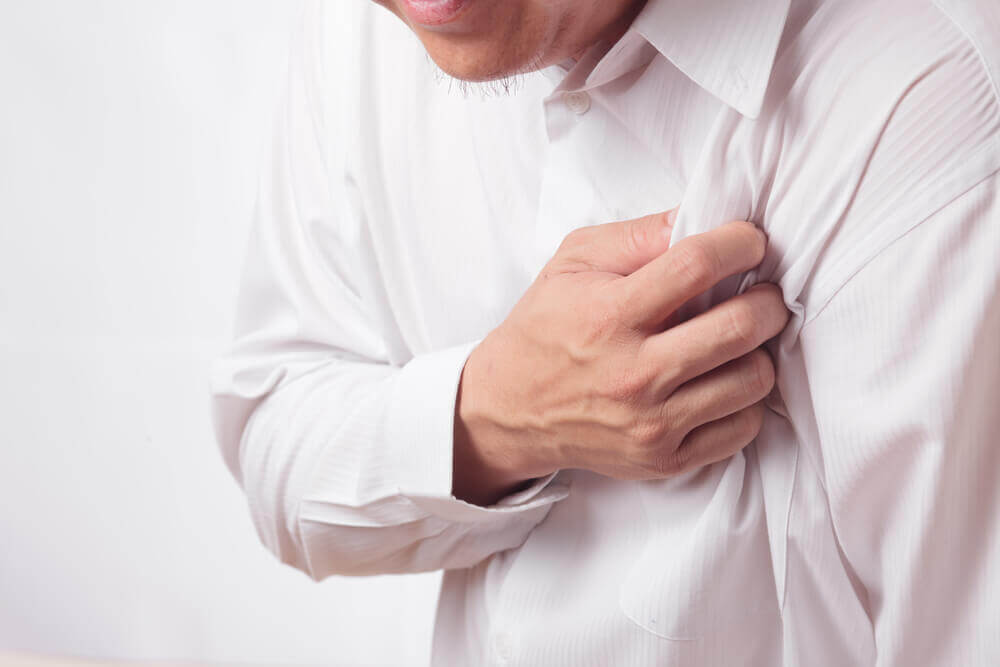What are the Causes of Underarm Pain?


Written and verified by the doctor Mario Benedetti Arzuza
It’s likely that at some point, you’ve experienced underarm pain. Considering that there are lots of blood vessels in this area as well as tendons and nerves, it’s not at all surprising that at some point you might experience discomfort in the region.
In most cases, this discomfort is due to a mild infection or swelling of small lymph nodes. However, this could also be an early symptom of breast cancer. Thus, it’s essential to consult a medical specialist and identify the cause of this discomfort.
Symptoms present when there’s underarm pain
The armpit is a delicate and sensitive region of the human body that can be affected by a number of conditions. In general, symptoms range from mild discomfort to severe irritation and discomfort. Some of the more characteristic symptoms that follow underarm pain are:
- Lumps
- Swelling
- Burning sensation in the area
- Extreme itching
- Numbness
- Pain (which can be mild, moderate, or severe)
Causes of underarm pain
Below, we mention the 11 probable causes of underarm pain:
1. A pulled muscle
There are several muscles of the arm and chest that cross the axilla, such as the pectoralis major, rotator cuff and the coracobrachialis muscle. Furthermore, strain of these muscles is characterized by sudden, sharp pain in the armpit.
It’s usually experienced by people who lift weights or perform similar exercises. In addition, sports such as baseball and tennis can also injure the muscles and tendons located at this level.
Moreover, muscle tension causes weakness, stiffness, fatigue and in some cases burning in the area. To solve it, it’s necessary to reduce inflammation and avoid moving this part of the body in order not to damage the torn muscles.
It’s recommended to use cold compresses for 20 minutes or opt for anti-inflammatory drugs. But above all, you must rest between three and six weeks. Furthermore, the doctor may indicate the use of analgesics and non-steroidal anti-inflammatory drugs, such as paracetamol and ibuprofen, to attenuate armpit pain and reduce inflammation.
Read also about What causes inflamed lymph nodes?
2. Axillary lymphadenitis
The lymph nodes are part of a complex network of immune system organs involved in the defense of the human body and the destruction of harmful agents. The condition known as axillary lymphadenitis occurs when the lymph nodes become inflamed.
This condition usually occurs under the neck, groin and armpits and some of its most characteristic symptoms are:
- Fever
- Swelling
- Pain when touched
- Redness and numbness
Axillary lymphadenitis is typically due to infection, however it can also be the result of more serious conditions. Doctors also perform a blood test to determine the cause and, in some cases, a biopsy is done to rule out the possibility of cancer.
3. Heart attack or angina

Angina pectoris presents as an intense pain in the center of the chest. This is due to a lack of blood supply to the heart muscle. This sensation may spread to other parts of the body, such as the armpits, arms, shoulders, neck and back. In addition, people may have:
- Difficulty breathing
- Heart palpitations
- Fatigue
- Dizziness and nausea
- Excessive sweating
If you notice pain in your chest and underarms, you should seek immediate medical attention.
4. Hidradenitis suppurativa
Hidradenitis suppurativa is a chronic disease that’s characterized by the appearance of nodules, scars, or abscesses in the region where you have sweat glands. This means that it commonly appears in the underarm area.
The lumps create tunnels under the skin, which block the follicles. It usually manifests with burning, itching and excessive sweating in the armpits. Over time, this area hardens and changes color, and may even release pus. Risk factors include:
- Overweight
- Smoking
- Weak immune system
- Hormonal changes
5. Breast cancer
Just because breast cancer is one of the possible causes of pain under the arms doesn’t mean that it’s the only one – so don’t be alarmed! The goal is to prevent it.
This type of cancer starts when your body attacks the cells of the ducts that produce milk in the breast tissue. It can also originate in glandular tissues. If you have inflammation in your lymph nodes, they can affect the underarm area. Some of the warning signs are:
- An inverted nipple
- A lump in the breast tissue
- Redness and itching
- Peeling skin around the nipple
- A change in the size or shape of the breast
If you have any of the symptoms mentioned here, you should have a mammogram or biopsy as indicated by your doctor to identify the cause of your pain and determine if it’s breast cancer.
6. Sebaceous cyst
This is a small soft nodule under the skin containing sebum and dead skin cells. These may appear spontaneously or be the result of an injury from shaving or waxing the armpits.
In most cases, these cysts do not cause symptoms. However, these bumps are susceptible to infection and can cause severe pain, redness and tenderness in the armpit. In general, you should consult a dermatologist to drain the cyst and start antibiotic treatment if necessary.
7. Intertrigo
Moisture, poor hygiene and friction in skin folds, such as the armpits and groin, favor fungal infections. Intertrigo is a skin mycosis caused by the fungus Candida albicans. Obesity and diabetes increase the risk of this disease.
Studies affirm that this condition manifests with reddish plaques, pustules, itching and intense pain in the affected area. Treatment is based on the use of topical antifungals and proper underarm hygiene.
8. Allergic reaction
The armpits, like other areas of the body, are also susceptible to developing allergic reactions. Research states that axillary fold dermatitis caused by friction between clothing and skin is seen with some frequency in atopic individuals. Other substances that can trigger an allergic reaction in the armpits include the following:
- Perfumes and cosmetics
- Deodorants and antiperspirants
- Hair removal creams
- Detergents
- Body soaps
9. Shingles or herpes zoster
Shingles is a painful skin condition resulting from reactivation of the varicella-zoster virus contained in the nerves, according to studies. Moreover, it usually presents as a rash of vesicles clustered in the intercostal region, in the armpits and on the face.
These lesions are accompanied by intense neuralgic pain in the area, fever, swollen glands and general malaise. Furthermore, the lesions usually disappear spontaneously after 1 to 2 weeks.
10. Acid reflux
In medical terms, this is known as gastroesophageal reflux disease or indigestion. This is because your stomach cells secrete acids that help break down food after you eat.
However, the muscles can weaken and gastric juices rise up into the esophagus in some cases, which causes burning in the chest that can spread to the underarm area.
11. Anxiety

Pain in the underarm region can also be somatic. Thus, this means there’s no physiological cause for it. However, your body is perceiving pain due to stress or prolonged anxiety.
Finally, people with anxiety become very worried and are constantly on edge, which causes physical discomfort. In these cases, it’s a good idea to try some relaxation techniques to reduce anxiety. In fact, you can’t relieve anxiety on your own or consult a doctor. Furthermore, they’ll recommend the appropriate medication to help you with it.
Avoid self-mediation
It’s important to evaluate your pain and discomfort before taking a pain reliever or other medication without consulting your doctor beforehand. Remember, taking medication of this kind can hide the symptoms and neglect the underlying problem.
All cited sources were thoroughly reviewed by our team to ensure their quality, reliability, currency, and validity. The bibliography of this article was considered reliable and of academic or scientific accuracy.
- Hagman, G. Trastorno de ansiedad generalizada. Salud(i)Ciencia. 2011
- Margarit Sonia. HEREDITARY BREAST CANCER. Rev. chil. radiol. 2008; 14( 3 ): 135-141
- Bonet R,Garrote Y. Angina de pecho. Enfermería (Ed. española). 2015;32(4):58.
- Garrote A. Micosis cutáneas. Offarm. 2002; 21(8): 82-90.
- Puig L. Dermatitis de contacto. Alergia e irritación. Farmacia Profesional. 2002; 16(8): 88-97.
- López M, Martínez M, Faura C, Pérez L. Herpes Zoster diseminado. Rev Clin Med Farm. 2012; 5(1): 64-66.
This text is provided for informational purposes only and does not replace consultation with a professional. If in doubt, consult your specialist.








